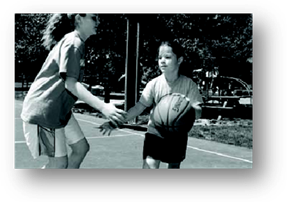AEROBIC ACTIVITY

Unit Overview
In this unit we will explore the benefits of aerobic activities.† We will also examine a few examples of activities that will help improve your cardio respiratory fitness.
You will also be completing another activity log for this week.
- Open another copy of the blank activity log. If you need to download a new copy, you can download it as a PDF file.
- Rename the activity log file, and save it on your computer.
- Remember to have a parent or guardian enter his or her e-mail address at the bottom of the form. This task should be completed by the parent or guardian, not by the student. Doing this is the equivalent of signing the form to verify that the student has completed the activities listed on the activity log. The e-mail address must be valid and belong to the parent/guardian. The teacher may contact the parent/guardian at this e-mail address at any time. The e-mail address will not be used for any purpose other than allowing the teacher to contact the parent/guardian. Entering the parent/guardian e-mail address is the equivalent of signing the form.
Introduction
Aerobic exercises help increase your cardio respiratory fitness. This is also called aerobic endurance or aerobic fitness.† Cardio respiratory endurance is the ability of the body's circulatory and respiratory systems to supply fuel and oxygen during sustained physical activity that lasts longer than a few minutes.†† Aerobic activity uses the large muscles in your arms and legs, increases your heart rate, and makes you breathe harder. Aerobic exercises, such as walking, biking, and jogging, are good for your cardiovascular system because they strengthen your heart, lower your blood pressure, and improve your circulation. And there's no substitute for aerobic activity when it comes to calorie burning and fat burning.† Below is a list of aerobic activities:
|
Ÿ Bicycling Ÿ Swimming Ÿ Skating
(Rollerblading) Ÿ Running/Jogging/Walking/Hiking Ÿ Cross-country
Skiing Ÿ Hurdlerís Jumps Ÿ Lateral Jumps Ÿ Soccer Ÿ Full-court
Basketball Ÿ Singles
Racquetball/Tennis/Badminton |
|
What does aerobic
mean?
Aerobic simply means "with air".† In other words, aerobic exercise is a kind of activity that requires oxygen.† You will know if you are doing an aerobic exercise because you breathe faster than normal. Thatís because your body requires more oxygen during an aerobic activity.†† If you give your heart an aerobic workout on a regular basis, your heart will get even better at delivering oxygen to all parts of your body.† So try some type of aerobic exercise the next time you workout.† Some activities you might want to try are swimming, basketball, ice or roller hockey, jogging (or walking quickly), in-line skating, soccer, cross-country skiing, biking, or rowing. And don't forget that skipping, jumping rope, and playing hopscotch are aerobic activities, too!
What
is aerobic exercise?
Aerobic exercise gets the heart
working to pump blood through the body more quickly and with more force than
normal.† As blood is pumped faster, it
must be oxygenated more quickly, which quickens respiration. Aerobic exercise
is any activity that you can sustain for more than just a few minutes while
your heart, lungs, and muscles work overtime. †
Aerobic exercise strengthens your heart and helps you maintain a healthy cholesterol level. Cholesterol is a fatty substance that is an important part of the outer lining of cells in the body of animals. Cholesterol is also found in the blood circulation of humans. The cholesterol in a person's blood originates from two major sources, dietary intake and liver production.†† That means some cholesterol is found in certain foods, and some cholesterol is produced by the liver. Too much bad cholesterol is not good for your heart.† So in other words aerobic activity helps keep your heart healthy.

Experts recommend that you work at a moderate level of
intensity, at least when you first begin an aerobic exercise program.† That means you shouldnít overdo when you
first start to participate in an aerobic activity.†† There are two ways to tell whether you're at
the moderate level. The simplest is the "talk test".† If you can still carry on a conversation and
the activity feels somewhat difficult, then you're probably working at the
right pace. If it's too difficult to talk and you find yourself panting, slow
down. That indicates that you're pushing yourself too hard. If you're breathing
easy and can belt out a tune while you're working out, you need to pick up the
pace a bit to burn fat.
Whether you walk around your neighborhood at home, at the mall, or around the track at a nearby school, walking gets you moving without any fuss. All you need are some good sport shoes, loose clothing, and a water bottle. Increasing your pace and pumping your arms as you walk boosts the intensity and the amount of calories expended without putting in any additional time. If the weather doesnít cooperate, have a backup plan, such as walking in an enclosed shopping mall. Many people fit aerobic activity into their mornings before work, during their lunch hour, or after dinner. It's up to you, and your plan can be flexible.

Teens
Need More Exercise
America's kids are in worse physical shape than they were 20 years ago. This is
particularly appalling since overweight teens often grow into overweight
adults, and overweight adults develop more heart disease, diabetes, and
arthritis. Every time you sprawl in front of the TV, your metabolism slows to a
crawl. Researchers at Memphis State University and the University of Tennessee
explored the link several years ago and were startled to find that kids'
metabolisms were lower while they were watching television than when they were
resting and doing nothing at all! The typical teen now spends almost 30 hours a
week in front of the tube, while eating high-fat snacks.
![MCj04347810000[1]](HEALTH_PEU14_Aerobic_Activity_image011.png)
Great
Exercises for Teens
Aerobic exercise is perfect for teens who are independent and like variety.
Some possibilities include running, in-line skating, cycling, swimming, power-
or race-walking, tennis, full-court basketball, aerobic dancing, kick-boxing,
Tae Bo, hockey, soccer, rowing, elliptical trainer, cross-country skiing,
jumping rope, racquetball, handball, ice-skating, and trampoline.
The American Heart Association suggests that teens raise their heart rates for 20 minutes without stopping, three or more times a week.† Aerobic exercise, when done correctly, shouldn't resemble running timed laps in gym class, when many kids feel like their lungs are ready to burst and their legs are on fire. This isn't about "no pain, no gain"; it's about choosing a fun physical fitness activity that also makes you sweat and breathe a little harder.
Exercise should never hurt.† A little muscle soreness can be expected, especially in the initial weeks of a workout program. Be sure you are stretching and warming up before any type of exercise. And keep in mind that if you are out-of-shape, you should start out slowly.† You may be more prone to serious injury if you do too much too soon.
![MPj03413400000[1]](HEALTH_PEU14_Aerobic_Activity_image013.png)
Ten
Good Reasons to Start an Aerobic Exercise Program
†
1.
Running and walking are convenient. All you have to
do is walk out the door and put one foot in front of the other. No need for
pools, courts, or fields.
2.
Running doesn't cost much. You can find many types
of exercise apparel at many discount stores.
3.
Your heart becomes more efficient at pumping blood
and oxygen through your body every time you exercise aerobically. You'll think more
clearly, and aerobic activity will make you a better athlete.
4.
It's an awesome time to chat with friends. (Talking
slows your pace, so you'll exercise longer.)
5.
It's a perfect time to be alone and think. You'll
be blown away by the creative thoughts, such as ideas for research papers and
ways to solve problems that you may have in your life.
6. Aerobic
exercise conditions your body to perform longer, faster, and more
efficiently.† This will help you if you
participate in other sports.
7. The more exercise you do, the more energy you'll have for hours afterwards. Your body will kick into overdrive after a few weeks of conditioning, and you will feel more energized than you ever have before.

8.
It makes you feel great physically. The progress is
truly dramatic! Every time you work out, your muscles develop strength and
power. Your lungs hold large amounts of oxygen. You'll find that you're staring
at yourself in full-length mirrors because you look AWESOME!†
9.
It makes you feel good mentally. Not everyone has
the discipline and ability to set a goal and reach it with slow, steady, hard
work.
10. Aerobic
exercise, especially running, can help make feelings of depression and
frustration disappear. After 20 or more minutes of continuous slow running,
your body releases powerful hormones called endorphins.† Endorphins are chemicals in the brain that are responsible for positive
moods.†† It's a good idea to
stretch your muscles after you work out to allow the muscles to release and
relax, as well as to improve flexibility. Spend a few minutes gently stretching
your muscles as you finish your walk or cool down.
Now that we've covered aerobic activity, it's time to cover the other major
kind of exercise, strength training. Strength training involves weight and
resistance training. We'll explore both topics in the next unit.
